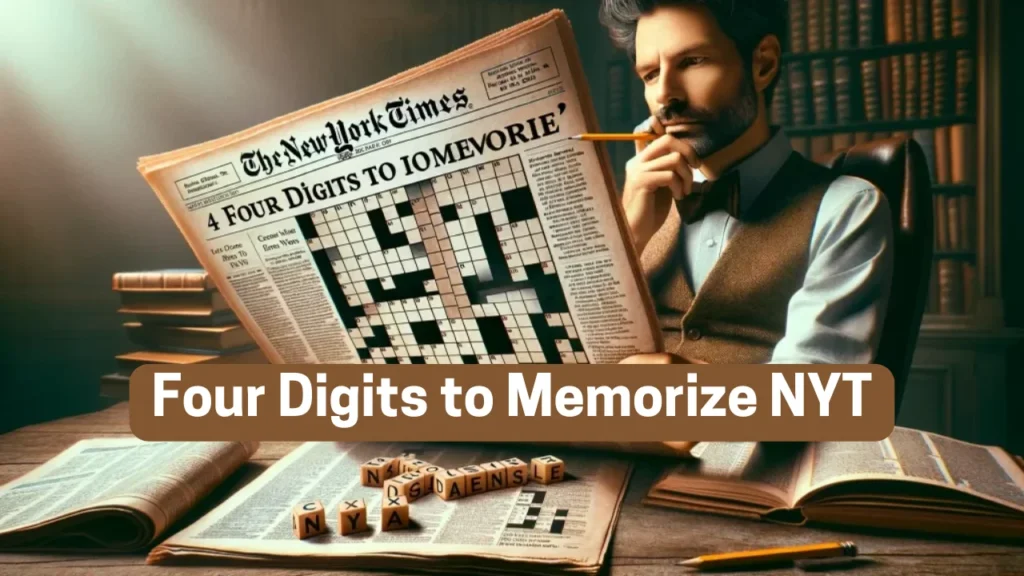What attracts many people to the “Four Digits to Memorize” puzzlement of the NYT is the challenge of combining logic, memory, and pattern recognition. It’s a unique puzzle format often appearing in the NYT games section, which calls for one to engage in a given set of four digits and remember them as they work through different clues and sequences. The objective is to find or derive the correct digits through careful analysis and deduction. As a brain-teasing exercise, it not only tests one’s numerical skills but also strengthens cognitive abilities related to memory and focus.
What is the NYT Puzzle “Four Digits to Memorize”?
The “Four Digits to Memorize” challenge is a mental exercise that was published in the New York Times. It asks readers to commit a sequence of four digits to memory and then remember it. This puzzle is hard and entertaining at the same time because it assesses logical reasoning, pattern recognition, and memory recall.
What Makes Memorization Crucial?
An essential component of cognitive growth is memorization.Mind games like “Four Digits to Memorize” are good for mental dexterity, focusing, and Memory. What’s more, this mental exercise helps keep the brain active and alert through years as it prevents aging minds from becoming dull by solving such riddles frequently.
How to Solve NYT Puzzle: “Four Digits to Memorize”
Chunking Technique
Using the chunking method, the four numbers are divided into more digestible, smaller portions. For instance, you can divide 4721 into 47 and 21 rather than learning it as a whole. It is simpler to remember the sequence when you use this method.
The Method of Association
Identifying a familiar object with the numerals is another successful tactic. For example, suppose the numbers are 1987. You could relate this number to some event in history that is very memorable or perhaps as someone’s birth year. Making an image or narrative out of the numbers can greatly help with remembering.
Reiteration
Memorization requires repetition. It can be beneficial to repeat the numbers aloud or mentally several times to help them stick in your memory. Your ability to remember the sequence rapidly will improve with continued practice.
Illustration
Seeing the numbers displayed in a certain arrangement or style can also be helpful. You could picture the numbers, for example, written on a whiteboard or arranged in a specific pattern. This kind of mental imagery can act as a potent cue for memory.
Benefits Of The Four Digits To Memorize NYT Technique
Enhanced Memory Skills
Then practice this puzzle regularly. With time, it will foster the capability of short-term memory about the digit pattern to be remembered. This would add to be able to retain and recollect information from your daily life.
Improved Concentration
It involves full concentration and optimum attention. This will help to develop your concentration, which can be very much useful both in professional tasks and in personal tasks requiring continuous attention.
Problem-Solving Skills
This puzzle enhances your logical reasoning and problem-solving skills and thus sharpens your mind as you try to apply strategies to find the correct sequences. You can use this critical thinking in other important, complex issues in your life.
Mental Agility
The puzzle keeps the mind sharp and agile. In such a way, the constant efforts of memorization and manipulation of numbers may help to preserve real cognitive flexibility that enables a person to adapt to novel situations and acquire new skills.
Stress Relief
Solving puzzles appears to be relaxing for most people. Being able to solve the “Four Digits to Memorize” is therefore a form of winding up and relieving stress.
Common Mistakes to Avoid
| Mistake | Description | Solution |
|---|---|---|
| Insufficient Association | Weak or vague associations between digits and words | Create vivid, personal, and absurd associations |
| Lack of Repetition | Not rehearsing the memorized information regularly | Review and practice recalling the information at intervals |
| Inconsistent Encoding | Using different associations for the same digits | Establish a consistent encoding system and stick to it |
| Limited Context | Not providing enough context for the memorized information | Use the NYT technique in various situations to reinforce learning |
FAQs
Q: What distinguishes the memory game “Four Digits to Memorize” from others?
The “Four Digits to Memorize” puzzle is simple to understand but difficult because it only requires memorizing a brief string of numbers. Because of its simplicity, solvers must use efficient memory strategies in place of sophisticated problem-solving abilities.
Q: How frequently is this puzzle featured in the NYT?
The NYT’s “Four Digits to Memorize” problem appears occasionally. It may show up in other parts, including the daily crossword or editions of special puzzles.
Q: Does figuring out this puzzle help kids?
Absolutely! Kids can gain a great deal by solving memory challenges. It strengthens their capacity to concentrate, retain knowledge better, and build cognitive abilities.
Q: Is there a way to practice this challenge using digital tools?
Yes, there are a number of internet and smartphone programs that provide memory tasks. You can practice and enhance your memorization skills on the fly using these tools.
Q: What should I do if I can’t remember the numbers?
If you have trouble remembering, begin with the easier activities and work your way up to the harder ones.The procedure can be streamlined by utilizing the previously discussed techniques, including chunking and association.
Q: Can I enhance my memory in general by completing this puzzle?
Playing memory games such as the “Four Digits to Memorize” can improve memory function in general. Frequent practice maintains the brain active and improves cognitive abilities.
Conclusion
More than a nice challenge, the “Four Digits to Memorize” NYT puzzle is really a very good tool for exercising cognitive skills and memory. Chunking, association, repetition, and visualization are some techniques the solver can apply to assist memory in numerical sequences. For either an experienced or inexperienced solver, this becomes a pleasant way to exercise one’s mind.
